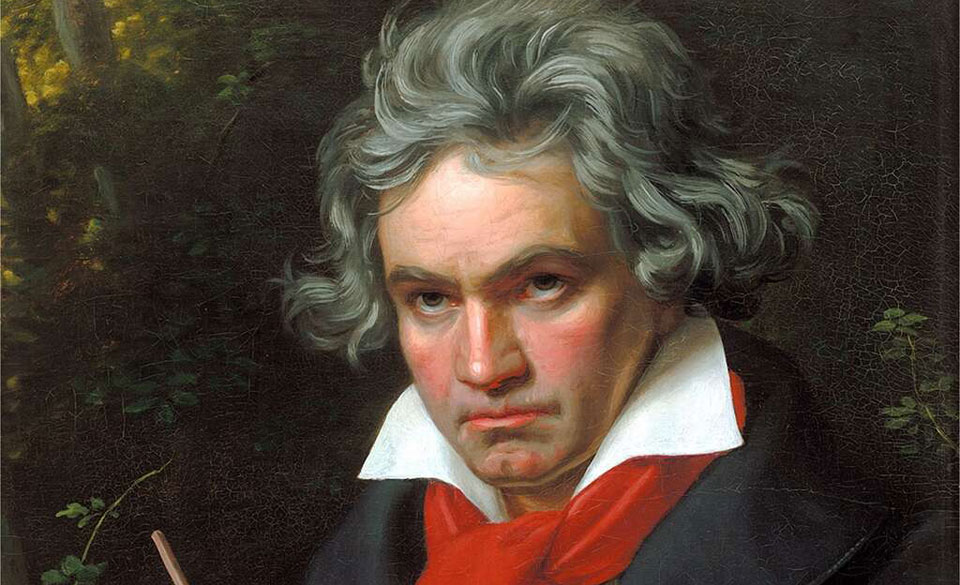
Like few other composers, Beethoven expresses the will for freedom, the democratic longing of the people. His music is the continuation of the French Revolution through the means of art; his Ninth Symphony is a hymn to the humanist utopia of the equality of all humankind.
Between 1905 and 1933 the “Ninth” was frequently performed in Germany to a large number of workers’ audiences with the participation of workers’ choirs including a “Peace and Freedom Celebration on New Year’s Eve 1918.” The beginning of this concert was scheduled so that at stroke of 12, the final movement began with Friedrich Schiller’s “Ode to Joy.” These concerts were stopped by the Nazis in 1933.
Beethoven’s Ninth symphony
The symphony was composed in 1823, but Beethoven had planned from youth to set Schiller’s “Ode to Joy” to music. Schiller’s poem, expressing the aspirations of the age of revolutions, was close to his thinking all his life.
The years since composing his eighth symphony had been times of bitter disappointment at the oppressive reactionary political developments after the Congress of Vienna, but also of personal suffering. They were also years of growing resistance to reaction, and the revival of the revolutionary ideals, betrayed by the upper middle classes. The Ninth Symphony symbolizes powerfully the struggle through night into light, of progress against reaction, to which Beethoven dedicated his whole life and work. It is often expressed in a struggle between a dark minor key and a brilliant affirmative major key. The finale of the Ninth anticipates and celebrates the victory of this ideal: a future society, in which freedom, equality, universal fellowship is fulfilled, in which Joy can reign.
The first movement portrays a great battle, heroic resistance against adverse conditions. Beethoven described the reactionary state of Metternich as the “chaos and despair in which we live.” This is enacted in the dark opening bars and theme 1 is in D minor, the key of despair. A world without joy. Downwards plummeting twitching motifs give rise to the increasingly vigorous theme of resistance.
This energetic battle cry is answered by a plaintive woodwind motif. Tutti chords express new, gathering forces that are extinguished in a downward-rushing gesture, as “despair” is brought back to mind. The heroic theme breaks through powerfully in B flat major, with a first anticipation of the Joy melody. This polarity between minor and major represents the symphony’s two protagonists.
The threatening mood returns, a recurring suggestion of suffering, of falling from a great height. An energetic tutti insists on resistance. The rhythmic struggle motif is the driving force of the development. Its contrast with a soothing motif is characteristic of Beethoven. Above the softly throbbing timpani rhythm of the struggle motif, grows a longing for peace and joy. In the movement’s climax, the heroic theme resounds over a mighty organ point with booming winds and swirling timpani. This concentration of strength, raging with pain and defiance, heralds a major change. Above the thundering organ point, the heroic theme once again appears majestically in D minor, contrasted with a painful, sinking motif. The movement’s final section evokes friendly images with the soft horn melody, intensified by further woodwinds.
The struggle has not been resolved. The state of “despair” is challenged, not eliminated. A solemn funeral march in D Minor moves the movement to a dark ending, yet it finishes with a gesture of defiance and belief in victory with the heroic motif played in unison.
The second movement opens in D minor but transitions into a joyful dance in F major. The entire orchestra plays a stomping dance theme; the woodwinds then cheer a joyful tune in C major. The recapitulation increases the sense of busy tumult; the coda follows with lively movement. Oboes and clarinets play a cheerful tune, reminiscent of Slavic folk music. This powerful folk melody, the joy of the people, has entered the first movement’s joyless world, with the movement ending brilliantly and optimistically in D major.
The third movement contrasts with the second movement’s active participation in life, with a wonderful adagio movement, a dreamlike vision of longed-for human happiness and peace. The first violins sing the soulful main theme, its variations make the movement increasingly fluid. Suddenly signal-like fanfares promise victory, sounding into the dream. The melody swings upwards, offering beautiful glimpses of that world of longed-for peace and joy.
The crowning final movement evokes life in community, in happiness and peace, a utopian vision. Beethoven merged the instrumental and the vocal for the first time in symphonic music, to express these revolutionary ideals, won through struggle, with the help of human singing.
At the start of the final movement, Beethoven surveys the ground that had to be traversed in order to reach this utopia, the hard-won realm of joy and freedom. The wild, dissonant outcry in thundering D minor, with which the wind groups begin the final section fortissimo over swirling timpani, seems to destroy all the hopes that the adagio had raised. This recalls the gloomy opening of the first movement. However, the C sharp in the bass pushes the motif into major. The recollected restless Scherzo theme is not yet a source of true joy, neither is the dreamy melody of the third movement’s adagio. Beethoven prepares the ground musically by having the low strings represent the hero who gradually rejects the main themes of the preceding three movements until finally, they embrace the “Ode to Joy” theme and with it the message of universal humankind.
The awakening of the Joy melody in the woodwinds is sounded in D major as from a distance. Beethoven notes, “Ha, this is it, it is found. Joy.” The bass recitative rejoices and picks up the melody to complete it.
This simple melody is in the manner of a folk tune. The joyful movement now moves into the formerly “joyless” space, a melody of a completely different kind than the wild turbulent one of the Scherzo: a noble folk melody. It is a tune expressing the human community, of people who have succeeded in the great feat, as Schiller’s poem says, and who are called to transform the world from a state of despair into a world of general peace, joy, and freedom. Beethoven now sings his high song to Joy. We are still in the realm of wordless music.
In a very lively orchestral movement, we hear the triumphal march of the Joy theme. At first, violas and cellos take over the melody, accompanied by the contrapuntal voices of double basses and bassoons. Then the Joy theme grows in the polyphonic choir of instruments to the triumphant march of the whole orchestra. A sudden pause, voices of doubt assert themselves. A cry of horror threatens to plunge everything into despair. Now the baritone singer, the voice of humanity enters.
The woodwinds play the theme. The solo baritone and the choir basses call out “Joy” to each other, with the soloist singing the Joy melody with Schiller’s words, accompanied by the interwoven sounds of the oboe and clarinet. The fully instrumented stream of the joy melody swells, reaching a climax at the words: “and the cherub stands before God!” repeated three times fortissimo, revealing reverence for the greatness of the universe. With a sudden turn to B flat major, Beethoven brings to light a new image: the triumphal march of joyful people, filled with the message of communal joy and a better world. From momentary silence emerges a march with the modified Joy melody, colored by piccolo flute and percussion. The march swells to a mighty storm. Even the joy of the human community can only be achieved through struggle. Both peace and joy are inseparable. This victory has been attained. The choir triumphs with the Joy melody in the splendor of the full orchestra in D major.
There follows the solemn proclamation of the universal human community: “Be embraced, Millions! This kiss to all the world!” These words are greatly enhanced by an extraordinarily vivid melody. Such a community of nations calls for a change in the social order. Beethoven combines with this his reverence for the cosmos, for the starry sky above. The composer’s fortissimo C major chord on “World” radiates splendor. The longed-for goal is presented as realized.
Thus begins the grandiose, crowning double fugue, in which the friendship of peoples and the joy of general human happiness are celebrated as an indissoluble unity. The polyphonically led choral multitudes are accompanied by undulating figures of the strings, by the brass groups with trombones and trumpets, and the enthusiastic shouts of “Joy! Joy!” of individual voices. The climax is reached on the long sustained high A on the word “world.”
Human community is emphasized. Beethoven sings of the “gentle wing” of peace and the understanding of all people. He lets the idea of peace shine once again in the great beauty of the solo quartet. A roaring orchestral epilogue with variations of the Joy melody concludes this powerful instrumental-vocal symphony.
Touring Syria in 2017, we visited a multi-denominational primary school in Homs. Suicide bombers had slaughtered 30 children and many parents. Here, young girls greeted us, movingly singing in Arabic the “Ode to Joy”: “Alle Menschen werden Brüder/All people are joined in common humanity.” The EU adopted “Ode to Joy” as its anthem in 1985, despite its stringent sanctions on Syria, making it more difficult for foodstuffs, fuel, and healthcare to reach the people. Such measures fly in the face of Beethoven’s humanist message.












Comments